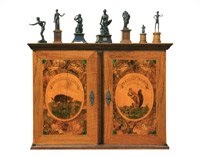Front: Kopf des Vespasianus mit Lorbeerkranz nach r.
Rear: Bündel von fünf Ähren. Umlaufend Beamtenname ΕΠΙ ΠΛΑΝΚΙΟΥ ΟΥΑΡΟΥ.
Pierced: Intentional hole(s) pierced through a coin so that it can be worn on a neclace, sewn onto textiles, etc. In case of paper money such a perforation often indicates devaluation.
en

